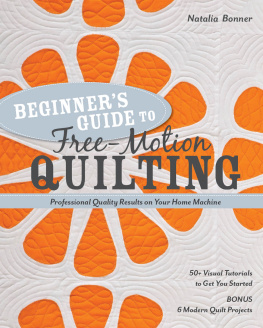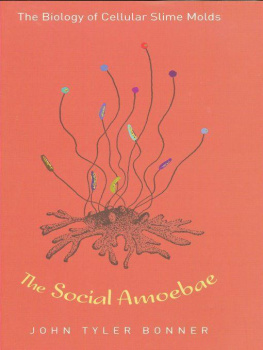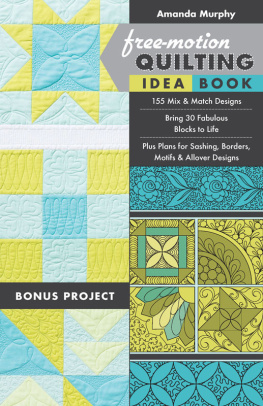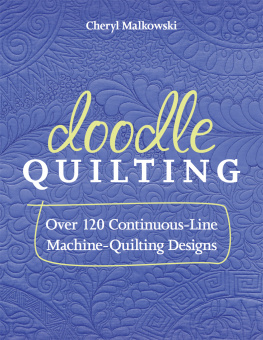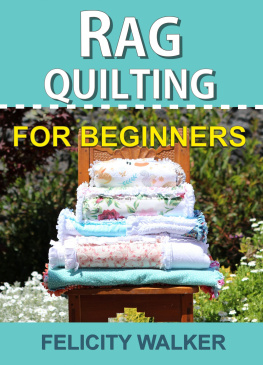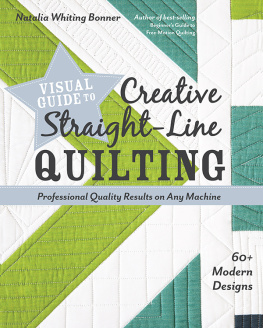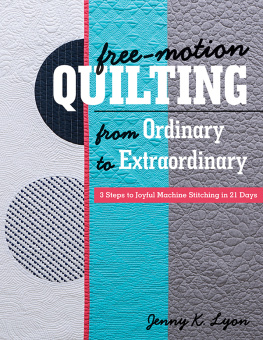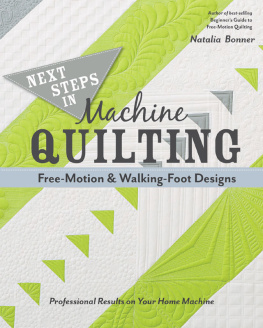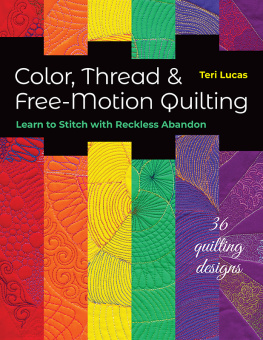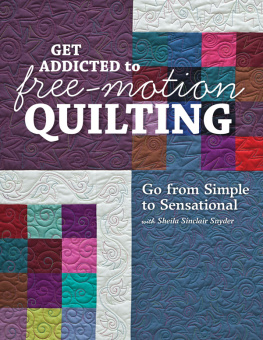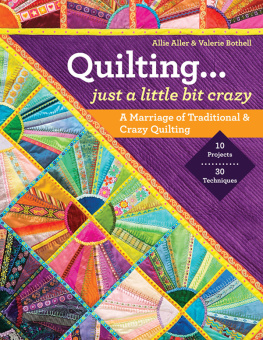
Dedication
This book is dedicated to the women in my life who I believe passed this love of quilting on to me. My great-grandmother Ella, on whose birthday I was born in 1982, was a traditional quilter who traced all of her pieces from a cardboard template and cut them out with scissors. All of her quilts were made with scraps from old clothing. My grandma LaRae wanted to be a quilter, but because she was severely crippled with arthritis, she was unable to quilt as much as she would have liked. My grandma Emmy is a hand quilter who puts hours and hours of time into her quilts. My grandpa refers to her as a topper, because she makes beautiful quilt tops and then stores them away under a bed until she has time to quilt them. Recently, she has let me machine quilt a few of her beautiful quilts.
My mom, Kathleen, sewed for my sister and me when we were growing up. She made us everything from our underwear to our swimming suits to the quilts on our beds. All the time I spent as a child watching her as she worked has influenced my life more than she can know.
Thank you to all of these women for teaching me and inspiring me. The skills and patience I learned from you as a child have now become the glue that keeps me in such close contact with cousins, aunts, and friends.
Acknowledgments
Special thanks to my whole family, but most of all to my mom, Kathleen Whiting. She has encouraged me and supported me from the day I got the crazy idea to leave my real job and pursue a career as a machine quilter. Thanks to my husband, Brad, and daughter, Chesney, for being patient with me day and night with my crazy quilting projects.
To Ashlee Woolf, Ilene Peterson, Vicki Christensen, and everyone else who helped me piece the quilts in this bookI could not have done all this without your help.
To everyone who reads my blog and attends quilt guilds with meyou have inspired and encouraged me more than you can imagine. Lissa Alexander and Angela Yostenyou saw something in me when I submitted my first Moda Bake Shop project.
To Moda Fabrics, Robert Kaufman Fabrics, and Riley Blake Designs for providing me with beautiful fabrics for this book.
To all the staff at C&T Publishing and Stash Booksyou believed in me. To Susanne Woods for encouraging me to make my dreams come true. And to Cynthia Bix, Diane Pederson, and everyone else on my C&T book teamthanks so much for all of your hard work and for holding my hand all the way through.

INTRODUCTION
Ive always liked to sew and craft, but for a long time I had no idea of the potential for creativity in making quilts. When it came to quilting, I was stumped about what to do once I had my piece all sewn together. I had no idea that I could actually machine quilt and finish my quilts in really creative ways on my home sewing machine.
I had been working as a dental assistant for several years when I found out I was pregnant with my first child. I decided that I was going to quit my job and stay at home full time. Once home, I began spending more and more time making simple projects such as placemats and table runners and learning to machine quilt on them. I loved the feeling of satisfaction that came with finishing these fun, smaller projects. After I felt like I had mastered placemats and table runners, I moved onto quilting whole quilts.
I love to piece quilts as well as to quilt them. When the opportunity came to write this book about machine quilting, I thought, You cant have one without the other! I wanted to write a book that would include both machine quilting and piecing, and the result is this book.
This book has three main sections. In Focus on Quilting (), youll find simple patterns to copy and use, from loops to detailed feathers.
Whether you are new to machine quilting or already have some basic machine quilting experience, I hope this book inspires you to look beyond the basics, to think beyond your comfort zone, and to enjoy the journey.

Section One
FOCUS ON QUILTING
In this section, youll find all the basics about machine quilting, from choosing thread, batting, and fabrics to the ABCs of stitching on your quilt top. Then youll have a chance to try your skills with more than 50 illustrated tutorials for stitching allover quilting, quilting borders and sashing, and adding background fillers, as well as quilting on individual blocks and on appliqu.
Machine Quilting
BASICS

Detail of Amazed; full quilt,
Many people are intimidated by the idea of machine quilting, but if you give it a try and take some time to practice, youll find that its actually easy to do. Not only that, but its also creative and fun, and it gives you so much control over the final look of your quilt.
There are two basic kinds of machine quiltingstraight line and free motion. Many people start out by doing straight-line quilting. For this, you use a walking foot, pictured in Machine Feet (). This foot feeds the layers of your quilt evenly under the needle at the same time that the machines feed dogs feed it from underneath. You can use this foot to quilt parallel lines, grids, and diagonal lattice patterns. Straight-line patterns are easy to quilt and can be great fillers on a solid background, as shown in the detail of Amazed.
This book focuses on free-motion quilting, which allows you to quilt any kind of pattern you wish, from swirls and circles to flowers and feathers. Its a little like drawing on the quilt top with the needle. For information about the special machine foot you will need for free-motion quilting, see Machine Feet ().
TOOLS AND MATERIALS
Tools and materials for machine quilting are pretty simple: You need a sewing machine in good working order, with free-motion capability. You also need thread, needles, batting, and your quilt! Here youll find useful information about choosing among the many options within these simple categories. For recommended online sources, see Resources ().
Sewing Machine
Machine quilting can be done successfully on most conventional home machines, as long as the machine has a free-motion foot. I currently have a Bernina Aurora 440 and a Bernina Aurora 450. Its also helpful to have an extension table for your machine; this accessory creates a larger working area than the standard machine bed offers.
MACHINE FEET
When free-motion quilting, lower the machines feed dogs (the little teeth that move the fabric from underneath) and use a free-motion foot that lets you move the quilt layers freely under the needle. Free-motion feet for different machines vary (they are made in assorted shapes and can be metal or clear plastic) and can be called by different names, such as darning foot. A foot with a clear plastic sole is great because it provides improved visibility.
My Bernina has a BSR (Bernina Stitch Regulator), which is a foot that controls the sewing speed and helps regulate the length between stitches as you move the fabric. I really like the BSR foot because no matter what speed I move the fabric under the needle, my stitches always look about the same length.
Next page
